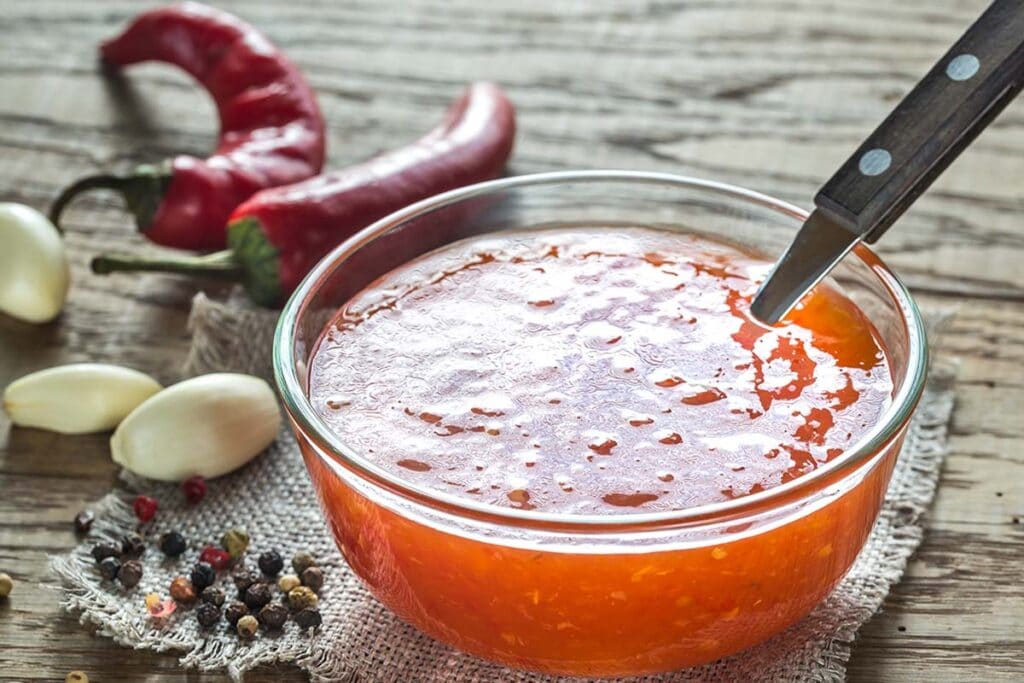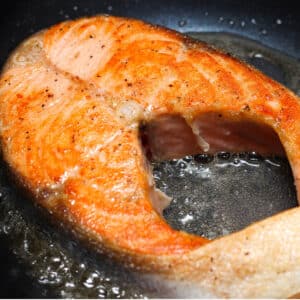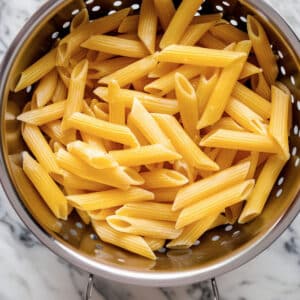Nothing quite matches eating a plate full of sweet-and-sour chicken made with beautiful moist chicken pieces, crunchy bell peppers, and slices of onion.
It is a small wonder that sweet and sour is one of America's most popular Chinese dishes. But reheating it is not always as easy as you might think, especially if you want to avoid ending up with dry, rubbery chicken.
But that doesn't mean you have to discard any leftovers. If you know the right way to do so.

Best way to reheat sweet and sour chicken
Reheating sweet-and-sour chicken, preserving its delicious flavor with that lovely crispy outer texture of plump, succulent chicken, is easy peasy.
Over the past few years, I have experimented with various ways of reheating leftover sweet-and-sour chicken.
I now have the definitive method that produces fantastic results, and I am willing to share it with you.
If you are interested to know how to reheat the sweet-and-sour chicken, so it's as good as it was when you first made it, you are about to find out.
In the process, I will tell you all about the different methods I've tried, which include:
- Using the air fryer
- Using the oven to reheat it
- Reheating it in the microwave only (no air fryer)
- Reheating it on the stovetop
Also, learn some of the useful tips on making sweet-and-sour chicken ahead of time and some of the best storage techniques that allow the reheated end product to be still lovely and crispy.
What's that, you say? Have you already got some sweet-and-sour chicken covered in sauce?
Just scroll down to the section where I tell you how to salvage and reheat the most delicious crispy sweet-and-sour chicken, and you'll be on your way.
But let's start at the beginning.
At the start of my quest, I ordered a large portion of sweet-and-sour chicken from my local Chinese takeout and told them that I would like the chicken and sauce separately packaged.
When I got it back home, I divided it up into several separate containers.
The day after, I reheated and tried each portion individually, giving each one marks out of 10 for how crispy the chicken was, how simple the method was, and how the aroma and flavor of each one turned out.
Method 1: the best of all - air fryer
I was always like it, even as a kid. If there were presents around, I simply had to open them there and then cooked.
- If the chicken is coated with sauce, make sure to remove the sauce from the chicken and pat it dry with a paper kitchen towel.
- Transfer the bulk of the sauce into an oven-safe dish and put the lid in place or cover with a cling wrap.
- Pop the sauce inside the microwave for 30 seconds interval or until heated thoroughly. Time depends on how much sauce you're reheating.
- Preheat your air fryer to a temperature of 390°F and reheat the chicken for two to three minutes.
- Before adding the chicken to the sauce and serving, allow it to rest on a wire rack for 1 minute.
If you don't own an air fryer, you can reheat the chicken in your oven or toaster oven. Whatever you do, don't cover it is that will prevent it from crisping.
An air fryer is the best way of reheating the chicken. You can use your oven or toaster oven, but in my experience, it's not quite as good.
If you don't possess an air fryer, you ought to think about buying one.
They come in handy for cooking and reheating all sorts of foods, and they're not particularly expensive.
My opinion
There is no doubt in my mind that this method is by far the best for reheating sweet-and-sour chicken. It even works pretty well when the chicken has been covered in the sauce for a couple of days.
Why is that?
It's the beauty of the air fryer - it's exactly what they're all about.
Even reheating sweet and sour chicken this way doesn't quite match the freshness of the sweet-and-sour when you bought it or originally made it - but it's only a whisker off.
Method 2: in the oven
This method works pretty well, too - maybe not quite as well as the first method, but it's not far away. Here are the steps to follow:
- Preheat your oven to a temperature of 350°F.
- Transfer the sweet-and-sour chicken, sauce, chicken and all, into an oven-safe dish and cover it with its lid or aluminum foil. This is to prevent the sauce from drying up.
- Place the dish into the oven and reheat for approximately 20 minutes. If you're reheating a huge batch, you might need to add 5 minutes to the cooking time.
- Remove from the oven, serve, and enjoy.
My opinion
this method works well, providing you're not too fussy about the chicken retaining its crispy outer. It doesn't work for me because crispy is king.
I am not overly keen on soggy reheated chicken, and unfortunately, that's what tends to happen when it's reheated in the oven. Apart from that, flavor and aroma-wise, it will still be delicious.
Is there a way around it?
Actually, there is. Before putting the dish into the oven, remove the chicken, pat it dry with a paper kitchen towel, place it onto a baking sheet and reheat in the uppermost part of the oven.
Method 3: in the microwave
The key thing with microwaves is that they're easy to use, and nothing is faster reheating.
However, the downside is that it will leave your chicken soggy, and if you microwave it for too long, it will become chewy.
If you want to take a chance, here's what to do:
- Separate the chicken from the sauce.
- Transfer the sauce into a safe microwave container, cover it with plastic food wrap, and pierce the wrap several times to allow any hot vapor to escape.
- Microwave for two or three minutes, depending on the size of the batch, but be sure to give it a little stir every 30 seconds or so.
- While the source is warming up, reheat your chicken in a saucepan, being careful to ensure it doesn't stick and burn.
- Combine, serve and eat.
My opinion
I only ever tried this method once, but that was enough for me. The chicken lost its crunchiness and, despite being cooked separately in a saucepan, it still ended up as a sorry, soggy lump - not for me.
If you are reluctant to throw the dish away, you could always remove the chicken and add something that has a little crunch.
You could, for example, fry some shrimp shelled and dusted in cornstarch; they only take about three or four minutes to cook.
Method 4: on the stovetop
Reheating takeout isn't the most challenging thing in the world. Using the stovetop method is pretty straightforward.
The best way is to reheat the chicken and the sauce separately, indifferent pans, and then plate them up together.
This method will get your sweet-and-sour chicken pretty close to as it was when you bought it or made it fresh.
The only problem is separating the chicken and sauce and then cooking into two pans creates more work and washing up.
Food hygiene and keeping leftover safe to eat
You might be shocked at how many people get ill every year by eating reheated takeout or other foods that were not stored or appropriately reheated.
Here's the best way of going about it.
Any leftovers you have should be allowed to cool and then refrigerated as soon as possible - certainly within two hours - no more.
- Transfer any leftover sweet-and-sour chicken into a hygienically clean airtight container, seal with a lid, or cover with plastic food wrap.
- Store in your fridge at a constant temperature of 40°F or less.
- Eat within two to three days at the latest.
Just ensure that when you reheat it, it is warmed thoroughly.
Ensuring your reheated sweet-and-sour chicken is crispy.
Keeping the leftover sauce and the chicken separate is key - right up to the point of serving. It's the only way of ensuring the chicken will stay crispy.
If the chicken is already immersed in the sweet-and-sour sauce, remove it and pat it dry with a paper kitchen towel. It won't be as crispy as originally, but it will still retain a slight crunchiness.
This is by far the best way of ensuring your chicken stays a little crisp - even more so if you use the air fryer process I described above in method one.
How to store sweet-and-sour chicken
The only way you should store sweet-and-sour chicken is in a covered airtight container which you then refrigerate at the earliest opportunity.
If you want to store it for longer than a couple of days, the best thing to do is freeze it.
Once frozen, sweet-and-sour chicken can be good for up to three months.
As I've mentioned several times already, it's best to store the chicken and the sauce separately to keep the chicken as crispy as possible.
At the risk of repeating myself, don't forget to pat the chicken down with a paper kitchen towel to remove as much sauce as possible before you pop it into the freezer.
Making sure your leftover sweet-and-sour chicken will be safe to eat.
According to information published by the Center for Disease Control and Prevention, around 48 million US citizens a year become ill after eating food that was handled and stored incorrectly. You don't want to be one of them.
As well as ensuring that reheated Chinese food reaches a temperature of 165°F, other recommendations made by the Academy of Nutrition and Dietetics include:
- Ensuring that you refrigerate any leftovers within 2 hours
- Make sure that any containers in which you store leftovers are hygienically clean.
- Confirm that your fridge temperature is a constant 40°F or less. If necessary, buy yourself a fridge thermometer.
Another thing that sometimes catches people out is leaving leftovers in the fridge for too long. They ought to be eaten within three to four days; otherwise, they could make you seriously ill.
My motto is - if in doubt, throw it out.
Can you freeze sweet and sour chicken?
Before you attempt to put sweet-and-sour chicken leftovers into your freezer, you must first allow them to cool completely.
Then, you should separate the chicken from the sauce and dab the chicken dry with a paper kitchen towel.
Transfer the sweet-and-sour sauce into a freezer-safe Ziploc bag (I recommend using the heavy-duty variety), evacuate as much air as possible, and seal.
Do the same with the chicken, albeit in a separate Ziploc bag.
Transfer the Ziploc bags to your freezer. Frozen sweet-and-sour chicken stored like this will be safe to eat for up to three months.
As well as separating the chicken, you might also want to remove the bell peppers. Once frozen, they will become mushy when defrosted. I find it best to freeze the sauce without them and then add fresh bell pepper when I reheat.
As far as defrosting is concerned, the best thing to do is remove the chicken and sweet and sour sauce from your freezer and store them overnight in the fridge.
By morning you will satisfactorily defrost them.
How long does sweet and sour sauce last?
We've already talked about the shelf-life of the chicken, so let's now talk specifically about the sauce.
The shelf-life of the sauce varies depending on the ingredients it contains. 99% of the time, its shelf-life is good for anywhere up to a year because of the vinegar it contains.
I don't think that most people would want to consider storing sweet-and-sour sauce in their fridge for as long as a year.
However, as long as it is stored in a tightly covered airtight container, it will be safe to eat and will retain its flavor for quite a while.

If you are someone who uses sweet-and-sour sauce regularly, you might want to keep it out on your kitchen worktop.
If you do, it is vital to store it in a tightly sealed, airtight container. It should be okay for between 7 to 10 days.
The one thing you must avoid is leaving it open so that the air can get at it. If you do, it will lose its aroma, coloring, and flavor.
It will also be susceptible to turning bad, especially if it's a homemade sauce that's no preservatives.
Using sweet-and-sour sauce in different ways
The sweet-and-sour sauce isn't just for sweet-and-sour dishes such as chicken pork or shrimp. It can also be used as a dressing or a dip.
Take care when you cook it to ensure it doesn't burn as the acrid taste that results isn't pleasant.
It's important, too, to try to balance the flavor. If it's too sweet or too sour, it can overpower whatever it is you're serving with it.
Making a homemade sweet-and-sour sauce
A lot of people buy premade, bottled sweet-and-sour sauce from their local supermarkets or Asian grocery stores.
For my part, I always prefer to make my own. It's not complicated. You can also check my recipe on how to make sweet and sour chicken.
What I like about this recipe is that you can bake it in your oven.
You can avoid all that last-minute faffing around and concentrate on your guests while the meal cooks itself.
Here's how:
- Transfer the ingredients into a suitably sized saucepan and bring to a boil on your stovetop, stirring continuously as you do so.
- Once it reaches boiling point, turn it down and let it simmer while you're preparing the chicken and dicing the veggies. Be sure to stir it from time to time to prevent it from sticking to the bottom of the pan and burning. Don't simmer it for longer than 20 minutes.
- Simmering will not thicken the sauce; instead, it will soften the onions and infuse the flavor throughout.
- Add the carrots, bell peppers, and pineapple to the sauce and combine thoroughly.
- Carry on cooking for 1 to 2 minutes, uncovered, to allow the sauce to thicken, stirring all the while.
- Transfer the sauce into the pan containing the chicken and stir until everything is nicely mixed. Serve, eat and enjoy.
Frequently asked questions
What's the best way of reheating sweet-and-sour chicken balls?
Use the same method as you would if you were reheating sweet-and-sour chicken.
Before cooking, pat dry with a paper kitchen towel to ensure they remain nice and crispy when cooked.
How similar are orange chicken and sweet-and-sour chicken?
Both of these dishes use chicken that has been coated and fried before it is added to the sauce. They are quite similar, but the sauce is somewhat different.
Orange chicken is lighter in color and is sweet, sour, and savory, unlike General Tso's or sesame chicken which is somewhat spicier.
Is it safe to eat cold sweet-and-sour chicken?
You can eat cold leftover sweet-and-sour chicken left out at room temperature for no longer than 2 hours, but why should you? It's not nice.
It's nowhere near as enjoyable as it is when served hot. The same goes for sweet-and-sour that has been left in the fridge for three or four days.
As far as defrosted sweet and sour chicken is concerned, it should be heated to an internal temperature of 165°F and eaten straightaway. It would be best if you did not refreeze it.




